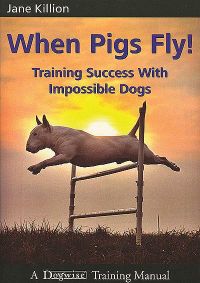Published by Dogwise Publishing, 2007
198 pages
This is the book that inspired the name for the school! Years ago when I got my first beagle rescue, I was struggling to get him to hear his name while on walks, nevermind train a loose leash walk. While walking on King Street, a woman driving by slowed down, rolled down her window, and said “Don’t bother! Beagles can’t be trained! They pull!”
If this sounds familiar to you, and you look in wonder why that neighbourhood Poodle, Border Collie, Golden Retriever, or German Shepherd are so naturally attentive to their owners, this book is for you.
Even if you happen to have that “naturally obedient” dog, this book is for you.
Of all the obedience training books I have read in the last few years, this is the most concise, clearly written training manual for dog owners of all levels.
Firstly, the book helps you understand why certain breeds are predisposed to handler attentiveness while others aren’t. Killion coins those dogs (the Collies, Shepherds, etc.) as “biddible” dogs, selectively bred for their ability and desire to pay attention to their handlers and follow instructions. Conversely, terrier and hound owners have “non-biddible” breeds that have been selectively bred for work that does not require handler instruction. She gives new meaning to the phrase “Release the hounds!”.
Secondly, Killion gives readers a clear and concise explanation of the laws of operant conditioning and clicker training, and specifically calls out the importance of using shaping techniques, not lure-reward methods, for non-biddible breeds. Non-biddible breeds are known for being stubborn, and as a result, training using shaping takes advantage of their natural breed characteristic of never giving up. The truth is, ALL dogs, biddible or not, learn better with shaping, so this is particularly why this book should be recommended reading for any dog owner looking to train their dogs.
Lastly, Killion spends the majority of the book on focus and attention, work ethic, and using real-life rewards to train our dogs. Some obvious examples are using sniffing for Beagles, jumping in a lake for Newfoundlands, or even jumping up and wrestling.
Hands down, this book is now my top recommendation for dog owners who are new to training. It is concise and easy to digest for casual dog owners, but without insulting their intelligence by omitting key concepts.

